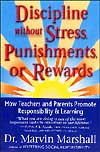Marvin Marshall is a professional speaker and seminar leader who presents his program, "Discipline without Stress, Punishments, or Rewards - Raise Responsibility and Promote Learning," to schools across the world.
His program was developed upon his returning to full-time teaching after 24 years of counseling, supervision, and administration. He has taught primary and upper elementary grades and has been an elementary school principal. He has taught all middle grades and has been a middle school counselor and assistant principal. He has taught all high school grades and has been a high school counselor, assistant principal of supervision and control, assistant principal of curriculum and instruction, and high school principal. He has also served as a district director of education.
Dr. Marshall is certified by the William Glasser Institute and annually presents at their International Quality Schools Consortium. He presents for Phi Delta Kappa and several leading seminar companies and at character education and other national conferences, including the National Staff Development Council (NSCD) and the Association for Supervision and Curriculum Development (ASCD). His presentation schedule is on the calendar of this website .
In his book Discipline
 without Stress, Punishments, or Rewards - How Teachers and Parents Promote Responsibility & Learning, he clearly and concisely demonstrates how the external approaches of relying on rules, imposing consequences, rewarding students for appropriate behavior, and punishing students to make them obey are all counterproductive.
without Stress, Punishments, or Rewards - How Teachers and Parents Promote Responsibility & Learning, he clearly and concisely demonstrates how the external approaches of relying on rules, imposing consequences, rewarding students for appropriate behavior, and punishing students to make them obey are all counterproductive.
Advance notification and autographed copies of his book can be made by contacting http://www.disciplinewithoutstress.com.
Chapter 1 shows how to reduce stress.
Three principles to practice are demonstrated: the power of positivity, the empowerment of choice, and the importance of reflection and self-evaluation.
Chapter 2 is about motivating others.
People attempt to influence others by using Theory X or Theory Y. After an explanation of these theories, the difference between external and internal motivation is explored. Then comes a discussion of rewards, punishment, and how these are two sides of the same motivational coin. The effectiveness of telling follows. The chapter concludes with a discussion of mindsets-those perceptions which drive motivation.
Chapter 3 describes The Raise Responsibility System.
This chapter describes a discipline program that is noncoercive, is based on internal motivation so youth want to be responsible, raises responsibility, and is easy to implement. The program has three parts. (1) Four concepts are taught. (2) When a student acts irresponsibly, checking for understanding is applied. (3) When a youngster continues to disrupt, authority is used without being punitive.
Chapter 4 is devoted to promoting learning.
The chapter begins with a discussion of the learning climate. Suggestions are given for improving relationships between the teacher and the class as a whole by reducing rules and instead implementing standards, courtesies and manners, and procedures. Relationships among students themselves and between the teacher and an individual student are improved by reducing anonymity and implementing tutoring. Strategies are then shared which include classroom meetings, collaboration-rather than competition-for quality learning, and reducing perfectionism. The chapter concludes with specific strategies for handling anger and impulse control, resolving conflicts, and dealing with difficult students.
Chapter 5 describes fundamentals for classroom teaching.
Topics include left and right brain hemisphericity, multiple intelligences, modalities of learning, emotions, styles, lesson planning, levels of intellect, instructional questions, group questioning strategies, choosing key words to frame questions and statements, imaging, stories, mindsets, metacognition, the senses, additional suggestions for aiding recall and memory, laser learning, seminal shifts, classroom management, and homework.
Chapter 6 offers essential practices for parenting.
Topics include practicing positivity, offering choices, encouraging reflection, using effective questions, listening to learn, limiting lecturing and telling, checking assumptions, focusing on the important, asking for assistance, recognizing implicit messages, fostering responsibility, exhibiting personal responsibility, recognizing desired behaviors, maintaining standards, using authority without being punitive, letting the youngster lead, teaching procedures to deal with impulses, intervening in sibling squabbles, being aware of sex differences, using acknowledgments more than praise, honoring homework, working smarter rather than harder, nurturing your child's nature, and reaping the joy of parenthood.
Epilogue - Argues that business is a poor model for learning.
Government, business, and even education leaders often compare schooling to business. Schools are referred to as workplaces, students as customers, and performance is measured in terms of accountability. Equating young people's learning processes with what adults do to make money is a false equation. Using a business model for learning is one of those practices which has been described by the comic strip character Dagwood Bumpstead, who said, "You know, that makes a lot of sense if you don't think about it."
Questions submitted to Kathleen Carpenter at kathleen@teachers.net will be considered by Marv Marshall for responses in future monthly columns in the Teachers.Net Gazette.
Click to visit Marvin Marshall's Homepage.

